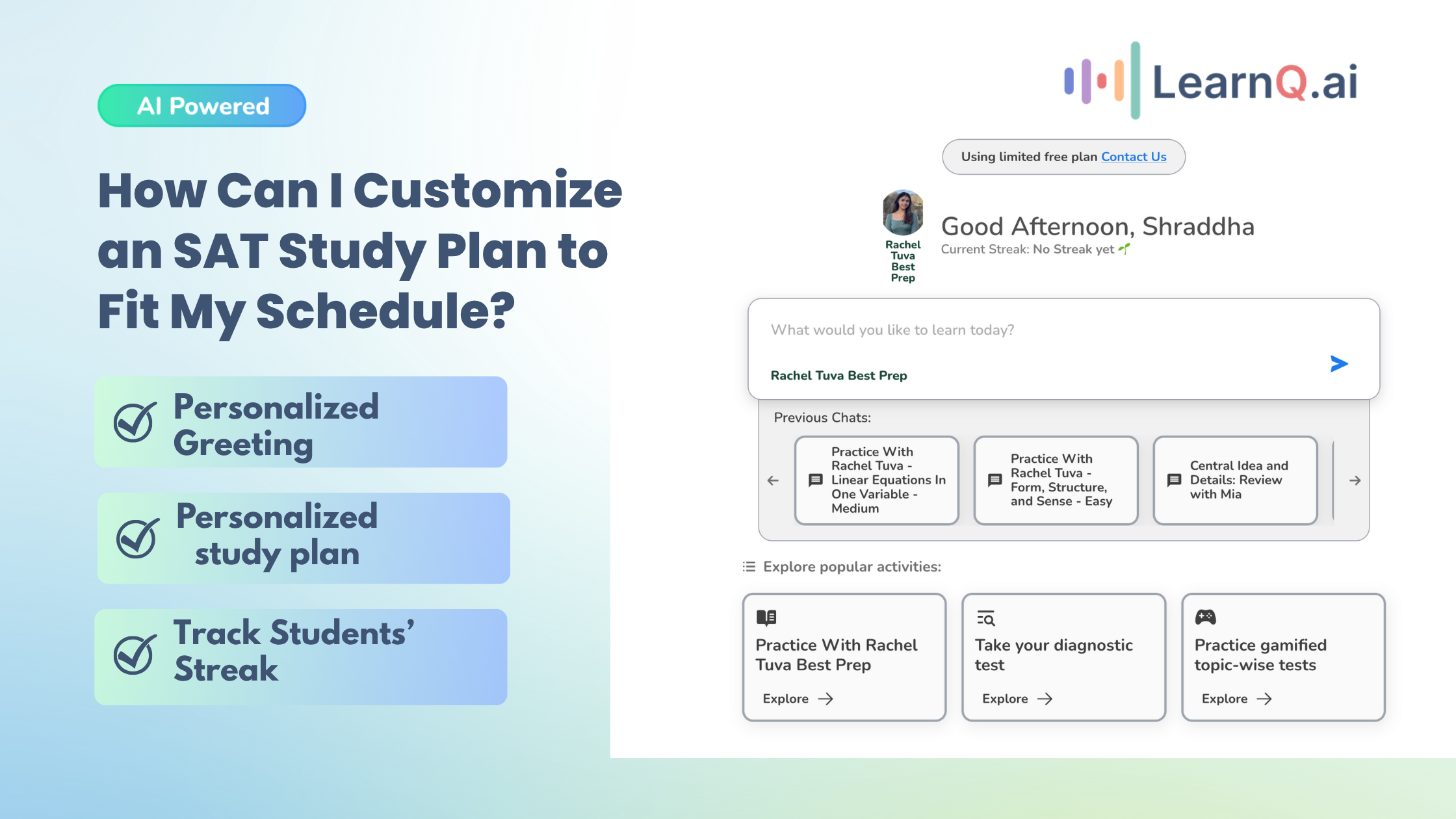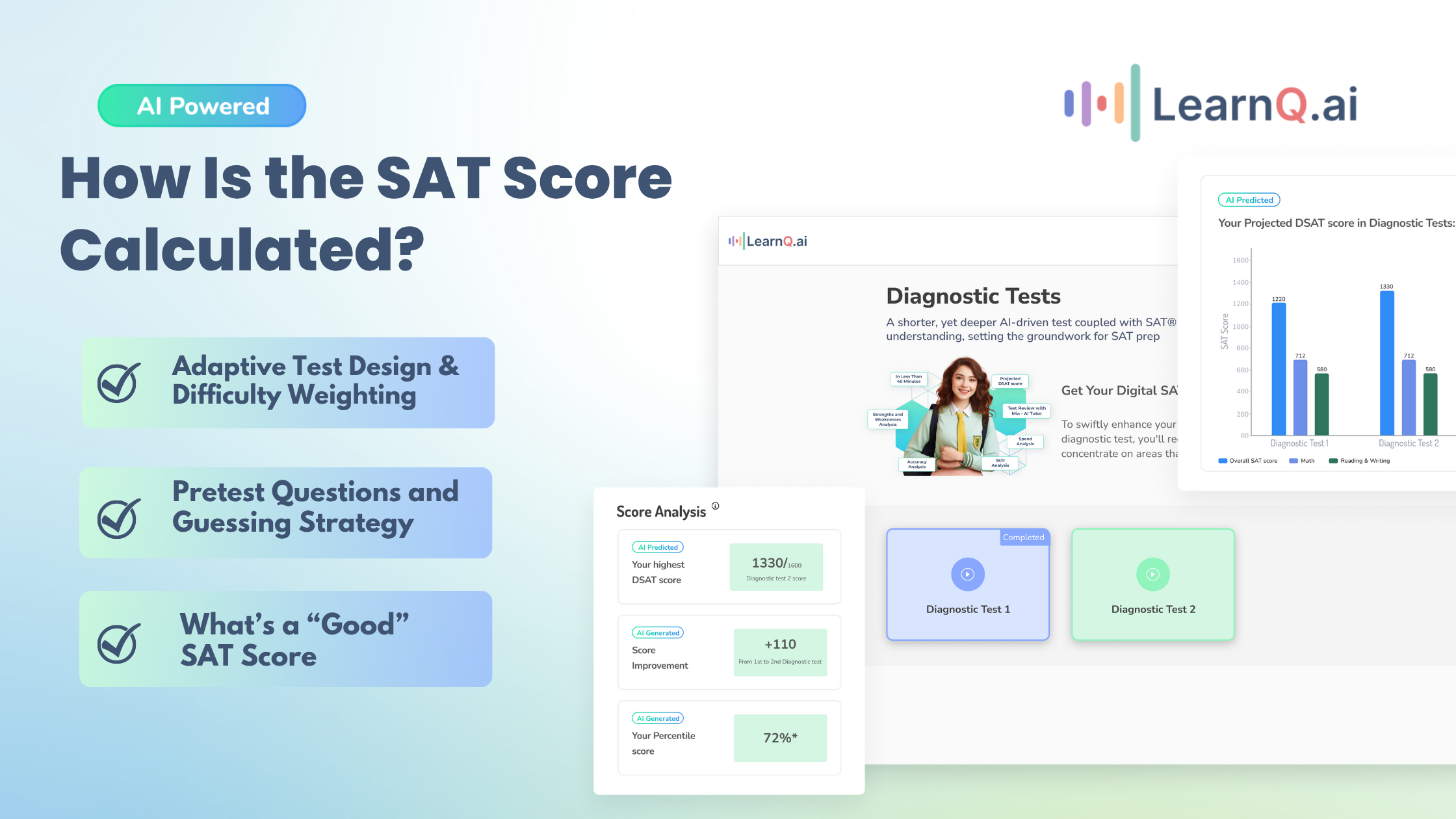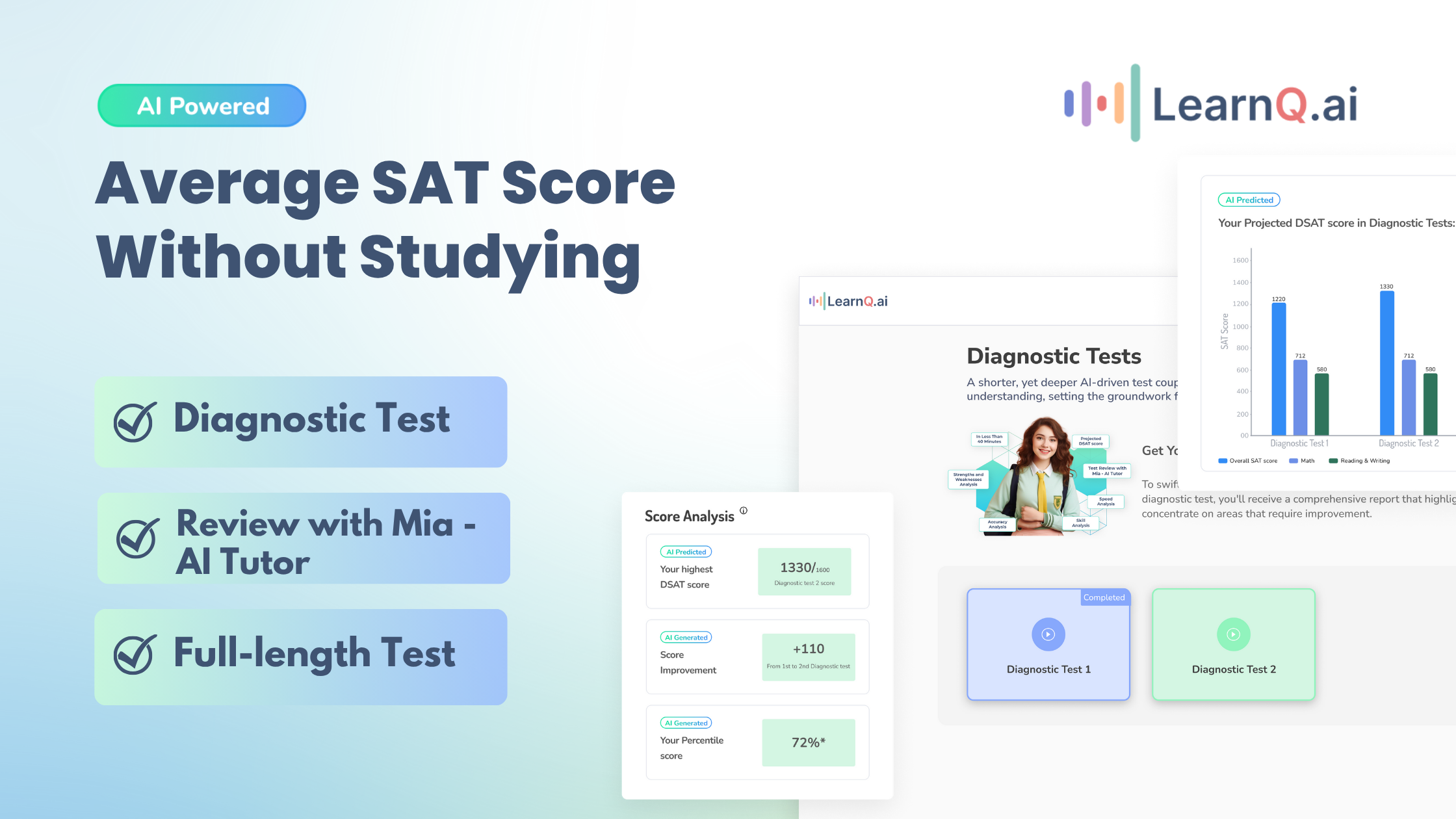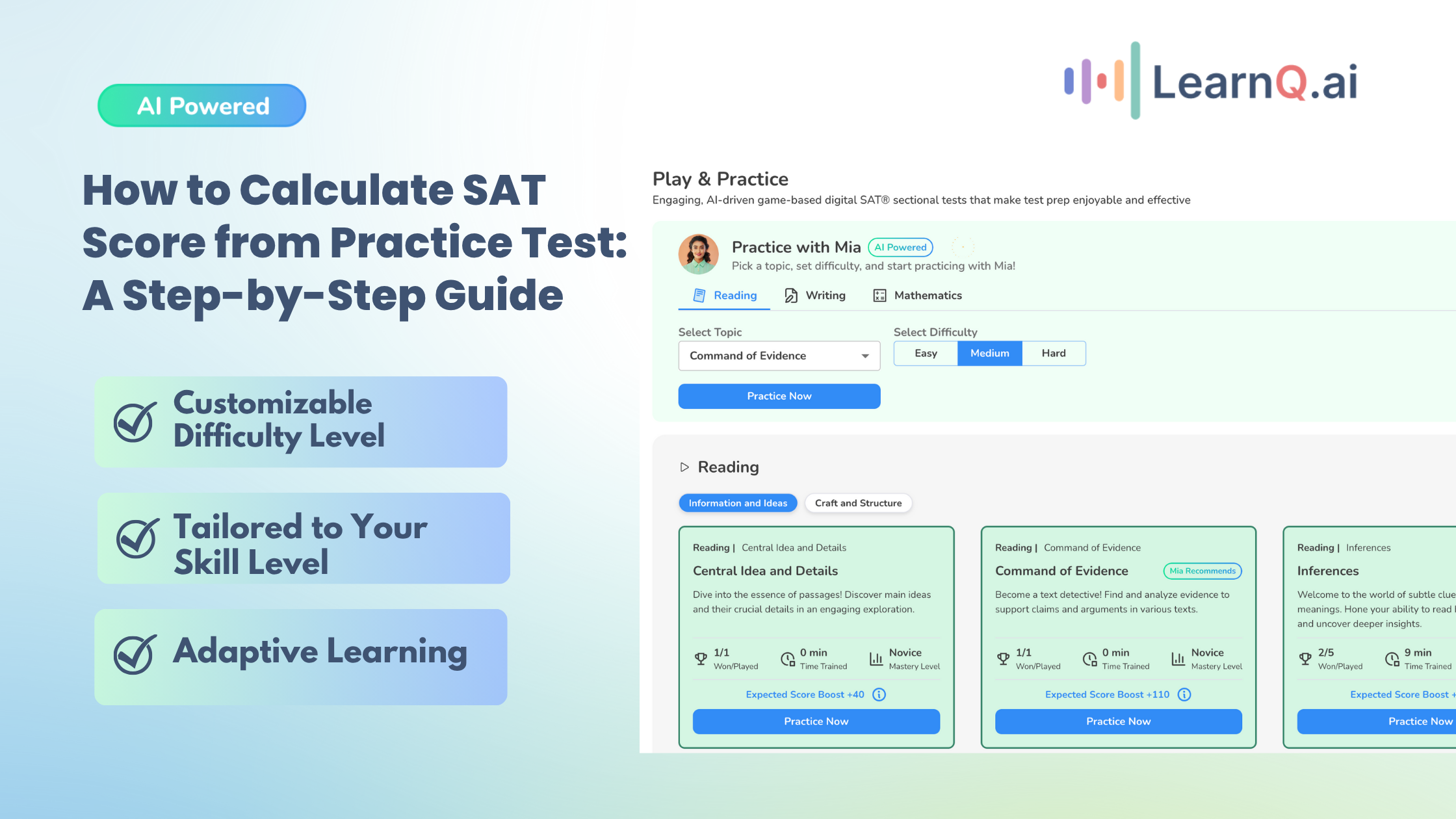Are you considering taking the Digital SAT and wondering if it’s possible to significantly improve your score with only a month to prepare?
The answer is yes! However, acing the DSAT requires focus, discipline, and the right strategies.
In this section, we’ll explore how you can effectively boost your Digital SAT scores in just four weeks. Yes, we will give you all the answers to your questions of- how to study for the SAT in a month.
The Possibility and Strategies to Improve Digital SAT Scores Within a Month
Let’s get into the central question of this article: Can you effectively prepare for the SAT in just one month? The answer is yes, but the feasibility of a one-month study plan largely depends on the extent of score improvement you aim to achieve.
To give you an idea of the commitment required, here are the approximate number of study hours needed for various total point improvements on the SAT, along with other tips;
| Points Needed to be Improved | Required Time |
| 0-30 | 10 hrs |
| 30-70 | 20 hrs |
| 70-130 | 40 hrs |
| 130-200 | 80 hrs |
| 200- 330 | 150 hrs |
As evident from the data, the greater the score improvement you desire, the more time you will need to invest in your SAT preparation. But what can be the starting point of the question, “How to study for the SAT in a month”? Let’s see;
- Starting Strong: The first step in your one-month preparation plan is to assess where you currently stand. Take a practice test to identify your baseline scores. This will not only reveal your strengths and weaknesses but also help you tailor your study plan to focus on areas that need the most improvement.
- Customized Study Plan: Break down your study sessions into focused blocks, dedicating specific times to each section of the SAT—Math, Reading, and Writing. Utilize resources like LearnQ.ai, which provides targeted practice tests and personalized feedback to help you hone your skills more efficiently.
- Realistic Goals: It’s crucial to set achievable goals. Aiming for a perfect score might be unrealistic if your initial practice scores are significantly lower. Instead, aim for a realistic improvement based on your starting point. For instance, improving by 100 to 200 points is a substantial and achievable goal for many students.
- Strategic Focus: Focus on the areas that contribute heavily to your score and where you can make the most significant improvements. If you struggle with Math more than Verbal, dedicate more study time to brushing up on algebra, geometry, and data analysis.
- Regular Practice and Review: Make the most of digital tools and platforms. LearnQ.ai, for example, offers a wide range of practice questions and mock tests that mimic the format of the Digital SAT. Regular practice under timed conditions will help you build speed and accuracy.
Creating an Efficient Study Calendar
A well-structured study calendar is key to preparing efficiently for the Digital SAT. By organizing your study time, you can maximize productivity, ensure comprehensive coverage of all test sections, and maintain your well-being.
In this section, we will discuss how to divide your preparation strategy into manageable tasks, include essential downtime, and adapt your study plan to fit both your commitments and the specific requirements of the Digital SAT.
Breaking Down the Test Prep Strategy into Manageable Daily Tasks
Efficient test preparation begins with a structured approach to your daily study activities. By breaking down your tasks into manageable segments, you can significantly enhance your focus and effectiveness. So, let’s see how you can break it down into small parts for easy implementation;
- Set Daily Goals:
Begin by setting achievable daily goals that contribute to overall test preparation. For example, allocate specific days to focus intensively on different sections such as Math or Critical Reading.
- Use Time Blocks:
Employ time blocking to dedicate certain hours of the day to studying, breaking down tasks into focused segments. This method helps prevent overwhelm and promotes deeper concentration.
LearnQ.ai is Powered by VEGA AI—Is your Institute Next?
Give students a Duolingo-style test-prep platform with Shopify-level customization for tutors and institutes.
Including Crucial Downtime to Prevent Burnout
To maintain the optimal balance between mental and physical well-being during your study sessions, it’s crucial to incorporate regular breaks. These pauses not only prevent burnout but also enhance overall productivity. Therefore,
- Schedule Regular Breaks:
Integrate short breaks into your study sessions to refresh your mind. Techniques like the Pomodoro Technique, which involves 25 minutes of work followed by 5 minutes of rest, can enhance focus and stamina.
- Plan Complete Off Days:
Ensure you have at least one full day off from studying each week. Use this time to engage in activities that you enjoy and that relax you, helping to reset your mind for the next week of preparation.
Structuring the Study Plan Around Commitments and Digital SAT Structure
To ensure a well-rounded study plan that accommodates both your academic and personal obligations, it’s important to strike a balance and plan effectively. Let’s see how you can do it;
- Balance Personal Commitments:
Acknowledge and plan around your personal and academic commitments. Ensure your study schedule is realistic and allows flexibility for unforeseen events or particularly challenging study days.
- Mimic the Test Structure:
Familiarize yourself with the Digital SAT’s format and tailor your study sessions to mirror the test’s structure. For instance, practice sections in their actual sequence and duration to get accustomed to the test’s pacing and pressure.
Implementation of the Study Calendar
Getting organized is key before you get into SAT prep. With just a month left until your test date, creating a study calendar can help you stay on track.
By building a calendar in advance, you’ll be able to allocate time for SAT prep and hold yourself accountable. Knowing what to study each day will keep you focused and on target.
To implement your study calendar effectively:
- Use Digital Tools: Utilize apps or digital calendars to keep track of your study schedule and adjustments.
- Review and Adjust Weekly: At the end of each week, review your progress and adjust your study plan based on what areas need more focus or which strategies are working best.
- Stay Flexible and Responsive: Be prepared to modify your study plan based on your ongoing performance and any changes in your personal circumstances.
Creating and adhering to a well-organized study calendar can dramatically enhance your preparedness for the Digital SAT, making your study time more productive and less stressful.
Efficient Study Calendar: A Visual Example
To visualize, consider creating a weekly calendar that outlines what subjects and tasks you’ll tackle each day, with specific times blocked out for each activity. Here’s a simplified example for a week:
| Day | Morning | Afternoon | Evening |
| Monday | Math – Algebra and data analysis (2 hours) | Break (1 hour) | Review errors from previous tests (1 hour) |
| Tuesday | Reading – Practice passages (2 hours) | Extracurricular activities | Free |
| Wednesday | Repeat Monday’s schedule with different math topics | ||
| Thursday | Writing – Grammar exercises (1 hour) | Write and review SAT essays (1 hour) | Light review or break |
| Friday | Mixed review sessions based on weakest areas identified during the week | ||
| Saturday | Full-length practice test under timed conditions | Review test results and identify areas for improvement | |
| Sunday | Rest day or light reading |
Understanding the Digital SAT Format
Before you get into mountains of practice problems, let’s take a deep breath and get acquainted with the digital SAT format. This way, you can approach test day with confidence.
The digital SAT might seem like a mystery at first, but it’s quite straightforward. Here’s a quick breakdown:
- Two Sections: The digital SAT has two main sections: Reading & Writing and Math. Each section is like a mini-quest, and you’ll have a set amount of time to conquer it.
- Scoring: Each section is scored on a 200-800 point scale. Add those scores together, and voila! You’ve got your total SAT score (between 400 and 1600).
- Question Types: Most of the questions you’ll encounter are multiple-choice. There are also some math questions where you’ll need to enter your answer directly. No pressure, though – there’s no penalty for guessing!
Also Read, The digital SAT exam details: Structure and Duration
Utilizing Practice Tests
Conquering the Digital SAT goes beyond just knowing the format. You need to train under pressure, replicating the real test experience as closely as possible.
Here’s the key: practice tests. Use them effectively, and you’ll see a massive boost in both your readiness and confidence come test day.
This section will equip you with the ultimate practice test strategy. We’ll cover how to:
- Leverage Full-Length Tests
- Review and Refine
- Schedule Regular Practice
By following these steps, you’ll transform practice tests from a passive exercise into a powerful tool for Digital SAT domination.
Taking Full-Length Practice Tests Under Test Conditions
Taking full-length practice tests under real test conditions is your key to Digital SAT domination. Here’s why:
- Simulation of Real Test Conditions:
To gain the most from practice tests, it’s essential to simulate real testing conditions. This means setting a timer, using only the allowed materials, and taking breaks only as permitted during the actual SAT. Sites like LearnQ.ai provide timed tests that mimic the pacing and pressure of the real Digital SAT.
- Importance of Regular Testing:
Incorporating full-length practice tests into your study routine helps you build stamina and adapt to the length and intensity of the SAT. Aim to complete a practice test weekly to continually assess your readiness and adjust your study plan accordingly.
Reviewing Practice Tests to Identify and Focus on Weaknesses
Don’t just take a practice test and move on. Make the most of it by reviewing your results:
- Detailed Analysis:
After each practice test, spend time reviewing every incorrect answer. Understand why you chose the wrong option and clarify the correct concept. This review process is crucial for turning mistakes into learning opportunities.
- Focus on Weak Areas:
Use your practice test results to identify patterns in your weaknesses. Whether it’s a particular type of math problem or reading comprehension questions, knowing where you struggle allows you to focus your study efforts more effectively.
Scheduling Regular Practice to Adjust Study Focus and Reduce Anxiety
Spread out your practice tests for the Digital SAT. This lets you adjust your studying as you go and keeps test anxiety at bay.
- Consistent Schedule:
Set a regular schedule for taking practice tests. Consistency not only helps in building a routine but also reduces test anxiety, as you become more familiar and comfortable with the exam format and question types.
- Adapting Study Plans:
Based on the outcomes of your practice tests, be flexible and willing to adjust your study plan. If you notice improvement in one area, it might be time to shift more focus to another section that needs work.
- Stress Management:
Regular practice under test-like conditions can also help manage anxiety. The more familiar you are with the testing process, the less daunting it will feel on the actual day. Practice mindfulness or other relaxation techniques post-practice to calm your mind.
Do you want to know, how many practice tests are required to ace the digital SAT? Read this blog!
Developing Effective Study Strategies
Honing your study strategies for digital SAT becomes critical to maximizing your performance on test day.
In this section, we focus on techniques for tackling challenging questions, balancing your preparation between strengths and weaknesses, and specific strategies for each major section of the test: Math, Reading, and Writing/Language.
Strategies for Approaching Difficult Questions
Don’t let tough questions throw you off track! Here are some key strategies to help you tackle them effectively:
- Understanding the Question:
Start by carefully reading and understanding what each question asks. Look for keywords and phrases that define the task, such as “compare,” “contrast,” “infer,” or “calculate,” which indicate the action you need to take. - Elimination Technique:
For tough multiple-choice questions, use the process of elimination. Cross out answers you know are incorrect based on your knowledge. This not only increases your chances of selecting the correct answer but also helps you focus on the most plausible options. - Time Management:
Allocate your time wisely. Don’t spend too much time on questions that seem too complex. Mark them and move on; return to them after addressing questions that are clearer to you. This ensures you don’t miss out on scoring easier points while stuck on more challenging problems.
Focusing on Strengths and Weaknesses
Don’t neglect either side of the coin! Here’s how to use practice tests to optimize your study for strengths and weaknesses:
- Regular Assessments:
Regularly assess your performance in practice tests to identify strong and weak areas. This assessment will guide where to allocate more study time and resources. - Balanced Preparation:
While it’s important to improve in weak areas, also spend time reinforcing your strengths. This balanced approach prevents overemphasis on weaker areas at the cost of potentially losing points in areas where you could excel.
You can opt for our diagnostic test, here!
Math, Reading, and Writing/Language Strategies
The Digital SAT throws a variety of curveballs your way, so it’s important to have section-specific strategies in place. Here’s how to tackle each section:
Math Strategies:
- Concept Clarity: Ensure you have a strong grasp of fundamental math concepts. Review algebra, geometry, statistics, and problem-solving techniques.
- Practice Application: Solve a variety of problems to become familiar with the different ways SAT questions can be framed.
Want to know more about math strategies and tips? Read our article!
Reading and Writing Strategies:
- Active Reading: Engage actively with the passages. Look for main ideas, authors’ arguments, and tones. Practice annotating passages to better retain information and reference back quickly.
- Question Tactics: Answer questions related to specifics in the text first since they are usually easier before tackling more complex inference questions.
- Grammar and Usage: Focus on improving your understanding of standard English conventions. Study grammar rules that the SAT commonly tests.
- Contextual Understanding: Practice identifying how word choice affects meaning and tone within the context of a passage. This skill is crucial for choosing the best replacements in improving sentences or selecting the correct word in vocabulary questions.
Getting Expert Help
As you prepare for the Digital SAT, considering expert help can significantly enhance your study efficiency and test readiness. One highly effective option is to utilize Digital SAT AI tutoring, which offers personalized lessons tailored to your specific needs.
Considering Digital SAT AI Tutoring for Personalized Lessons
Looking to take your Digital SAT prep to the next level? Consider the power of AI tutoring platforms. Here’s how they can supercharge your studies:
- Personalized Learning Experience:
Digital SAT AI tutoring platforms use advanced algorithms to assess your strengths, weaknesses, and learning patterns. Based on this data, they provide customized lessons that focus precisely on the areas where you need the most help. This targeted approach ensures that your study time is used efficiently, maximizing your improvement in the shortest amount of time.
- Immediate Feedback and Adjustments:
One of the key benefits of AI tutoring is the ability to receive immediate feedback on your practice tests and exercises. This instant response allows you to understand your mistakes right away, learn from them, and adjust your approach to subsequent questions. This dynamic learning process is crucial for rapid improvement.
- Flexibility and Accessibility:
With digital tutoring, you have the flexibility to study anytime and anywhere, as long as you have internet access. This makes it easier to fit SAT prep into a busy schedule, ensuring that you can consistently work on improving your scores without having to commit to a rigid tutoring schedule.
- Expert Resources and Strategies:
AI tutoring platforms often incorporate teaching strategies and resources developed by test prep experts. These include practice questions, video lessons, and strategic tips that are proven to help students succeed. The platforms continuously update their content and strategies based on the latest SAT formats and standards, providing you with up-to-date preparation materials.
- Cost-Effectiveness:
While private tutoring can be expensive, digital AI tutoring often comes at a fraction of the cost, making it an economical option for many students. Some platforms even offer some level of free access, which can be a great way to test out their services before committing to a paid plan.
Read more about AI tutors here!
Enhance your Digital SAT study routine with AI-driven insights and personalized practice tests.
Digital SAT Prep Materials
One of the important parts of your question- “how to study for the SAT in a month?” is how you streamline your study plans. LearnQ.ai is here to help streamline your study plan with targeted tools and resources:
- LearnQ.ai’s Practice Tests: Kickstart your preparation with our practice tests. They are crafted to mirror the real SAT, helping you get accustomed to the question formats and timing.
- Play and Practice Tests: Make studying less daunting and more engaging with our Play and Practice tests. These interactive tests make learning fun and can help enhance your retention of key concepts.
- Diagnostic Tests: Not sure where to start? Our diagnostic tests are perfect for identifying your strengths and areas for improvement. This way, you can focus your study time more effectively and efficiently.
- AI Tutor Mia: Meet Mia, your personal AI tutor. Mia is ready to guide you through your SAT prep with personalized tips and feedback. She adapts to your learning pace and style, ensuring you get the most out of every study session.
Read more about the latest digital SAT books and practice tests here!
Final Preparations and Test Day
The last stretch before your Digital SAT is crucial. This period is not just about brushing up on your knowledge but also about setting yourself up for peak performance on test day. It’s the last step of the question- “How to study for the SAT in a month?”
Here’s how you can make the most of your final preparations and ensure you are fully prepared for the big day.
Using the Final Week for Focused Strengthening of Areas
- Targeted Review:
In the last week before your test, focus on strengthening areas where you’re still struggling. Use concise, targeted practice based on the feedback from your latest practice tests. This isn’t the time for broad study but for addressing specific weaknesses.
- Practice Under Timed Conditions:
Continue to practice under timed conditions to keep your test-taking reflexes sharp. However, reduce the volume of questions to avoid burnout. Concentrate on quality and strategy over quantity.
Avoiding Studying on the Day Before the Test to Rest the Brain
- Mental Rest:
Give your brain a rest the day before the test. Avoid any heavy studying or new material. This day should be about mental relaxation to ensure you are mentally fresh for the exam day.
- Light Review Only:
If you must study, limit yourself to a light review of notes or flashcards. Focus primarily on consolidating your confidence in what you already know well.

Preparation Tips for the Test Day
- Plan Your Route and Timing:
Ensure you know exactly where your test centre is and how long it takes to get there. Plan to arrive early to avoid any last-minute stress that could affect your performance.
- Prepare Your Materials:
Pack everything you need for the test the night before. This includes your admission ticket, photo ID, approved calculator (if applicable), and snacks for the break.
- Dress Comfortably:
Wear comfortable clothing appropriate for the testing environment. Consider layers to accommodate varying room temperatures.
Keeping Everything Needed for the Test Ready
- Checklist of Essentials:
- Admission ticket and photo ID.
- Snacks and water for breaks.
- Night Before Preparations:
Ensure everything is packed and ready the night before. Check the functionality of your calculator and set aside the clothes you plan to wear.
What now? You are all set for the day. But still, want to know some of the important tips? Read our blog!
LearnQ.ai is powered by VEGA AI—Is your institute next?
Offer students a Duolingo-style test-prep platform with Shopify-level customization for tutors and institutes.






Wrapping Up,
You’ve made incredible strides in your SAT prep over the last month, and got aced the answer to the question, “How to study for the SAT in a month?”. Now it’s almost time to show what you’ve accomplished.
As you gear up for the big day, remember, that this isn’t just about recalling facts—it’s about showcasing your critical thinking and problem-solving skills. Make sure your test day strategy is set: check your materials the night before, get a good night’s sleep, and have a nutritious breakfast.
Trust in the hard work you’ve put in, especially those hours you’ve dedicated to LearnQ.ai. Our resources are designed to give you that extra edge, making your prep smoother and more efficient.
Walk into your exam with confidence—you’re more than prepared. You’ve got this!











